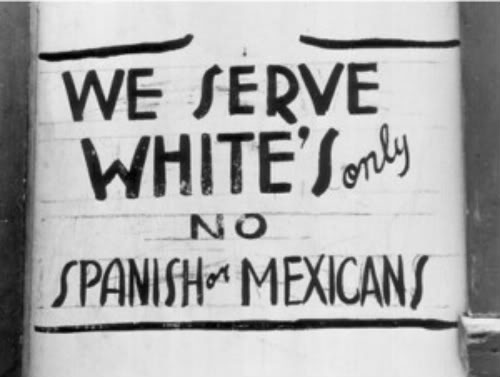In 1940s war-time Los Angeles, Mexican Americans faced a lot of discrimination and segregation--in housing, education, and employment. Even leisure activities like swimming and going to the movies were segregated. Mexican Americans, whose ancestors had founded the city Nuestra Señora de Los Angeles less than a hundred years earlier, found themselves second-class citizens in their own city by the 1940s.
Mexican American teenagers growing up in this atmosphere of second-class citizenship used fashion, culture, and solidarity to express their identity, and to assert their rebellion. Dressed in baggy Zoot Suits, a style adopted from African Americans and the LA jazz scene, Mexican American youth left their East LA barrios and hit the jazz clubs of downtown LA along Central Avenue. Defying war-time clothing rations, these "pachucos" began to be seen as dangerous juvenile delinquents, and were repeatedly represented as such in sensationalist news headlines.
Newspapers ran side-by-side headlines regarding the foreign threat of the "Japs" and the local threat of Mexican American youth, or "pachucos." This tension was heightened by the presence of 50,000 US Navymen in LA, awaiting deployment for war. The sailors and Mexican American youth often clashed in the night clubs and on the streets.
An incident involving the death of a young Mexican American serviceman led the LAPD to crack down on "pachucos." Hundreds of youths were arrested in a dragnet. The lead police investigator was a pulp writer named Clem Peoples, who wrote sensationalist articles about these arrested Mexican American "delinquents."
Thus began a battle of narratives which, in retrospect, demonstrates a central social conflict between Mexican and Anglo Americans in Los Angeles. In the press, fueled by Clem People's articles and popular stereotypes, there emerged an image of delinquent, law-breaking, socially deviant, violent youth, confirming Anglo-American fears. The other narrative, from the perspective of the "pachucos" was one of a group of young men seeking to express their culture and unique identities in an environment of great racism and discrimination. From a Mexican American perspective, these young men represented a valiant defiance of the second-class citizenship to which they had long been subjected.
Seventeen Mexican American boys were arrested and ultimately convicted. The so-called leader, Hank Leyvas, was sentenced to life in San Quentin prison. In this well-publicized trial, there was pressure on public officials to convict these "delinquents" to assuage public (Anglo) fears. Though the evidence was not conclusive, they were convicted.
In response, celebrities (like Orson Welles and Rita Hayworth), activists, educators, and citizens who were sympathetic to the plight of these youths formed a committee to raise awareness and funds for an appeal. Those on the committee argued that these boys hadn't been given a fair trial and had been "railroaded" into a conviction.
During the trial and its aftermath, tensions between Navymen and "pachucos" erupted into violence. Each fight provided a reason for the next. News of the fights spread outside of LA, and more servicemen and civilians from as far away as Las Vegas poured into LA and descended upon Mexican American neighborhoods with clubs and other weapons. Soon, there was a full-scale riot.
The Anglo press and public clearly favored the Navymen. This was World War II, and to fight back against a Navyman was tantamount to treason. Police were sympathetic to the Navymen. After a fight or riot broke out, police would come in and arrest the "pachucos." The Navymen were given rides back to their base, regardless of who was the instigator or aggressor. This double-standard among law enforcement (giving whites impunity and punishing minorities) clearly has a long history. Often, the Navymen would strip the pachucos of their zoot suits and burn them.
The riots lasted until the government intervened, banning Navymen from downtown, and banning the wearing of zoot suits. When Hank Leyvas and the others won their appeal, Leyvas left the courtroom wearing a soot suit. The governor of California ordered a committee to investigate the cause of the riots. They found that racial discrimination was a contributing factor. In response, the mayor of Los Angeles stated publicly the familiar Anglo narrative: Racial discrimination was not a factor. The cause was simply juvenile delinquency.
As is often the case, the truth of the Zoot Suit riots lies somewhere between the two narratives, between the Anglo narrative of righteous servicemen "cleaning up" Los Angeles, and the Mexican American narrative of standing up to discrimination. Yes, the "pachucos" were violent. But so were the servicemen. By attributing the cause simply to delinquency and laying the sole blame on the "pachucos," the mayor of Los Angeles simplified a complex issue. The underlying cause was indeed widespread racial discrimination, and both sides contributed to the violence. Unfortunately, the Anglo narrative was the one that persisted in the minds of many people, and this legacy of "racial innocence" persists today.
But the question, uncomfortable as it is to ask, must be asked…Why were these youths violent? That is the question that rarely gets asked in discourse about youth crime, especially among minorities. In the case of the pachucos, their violence did not spring out of a vacuum, or even out of their natures. The violence was the result of the larger social issue of racial discrimination. Another fascinating documentary that explores these complex/uncomfortable questions is Stacey Peralta's Crips and Bloods: Made in America, which demonstrates how youth gangs in LA formed as a reaction to racist housing covenants, and widespread discrimination. That's the question that must be asked: How are we, how am I, complicit in these problems, and what can we, what can I, do to make change? The answer is not in assigning blame to some abstract "other". The answer lies in understanding, self-reflection, and the courage to talk about uncomfortable things like this, and to act in accordance with what is right and just.
The entire PBS documentary is available to watch on youtube. It's well worth an hour of your time.



